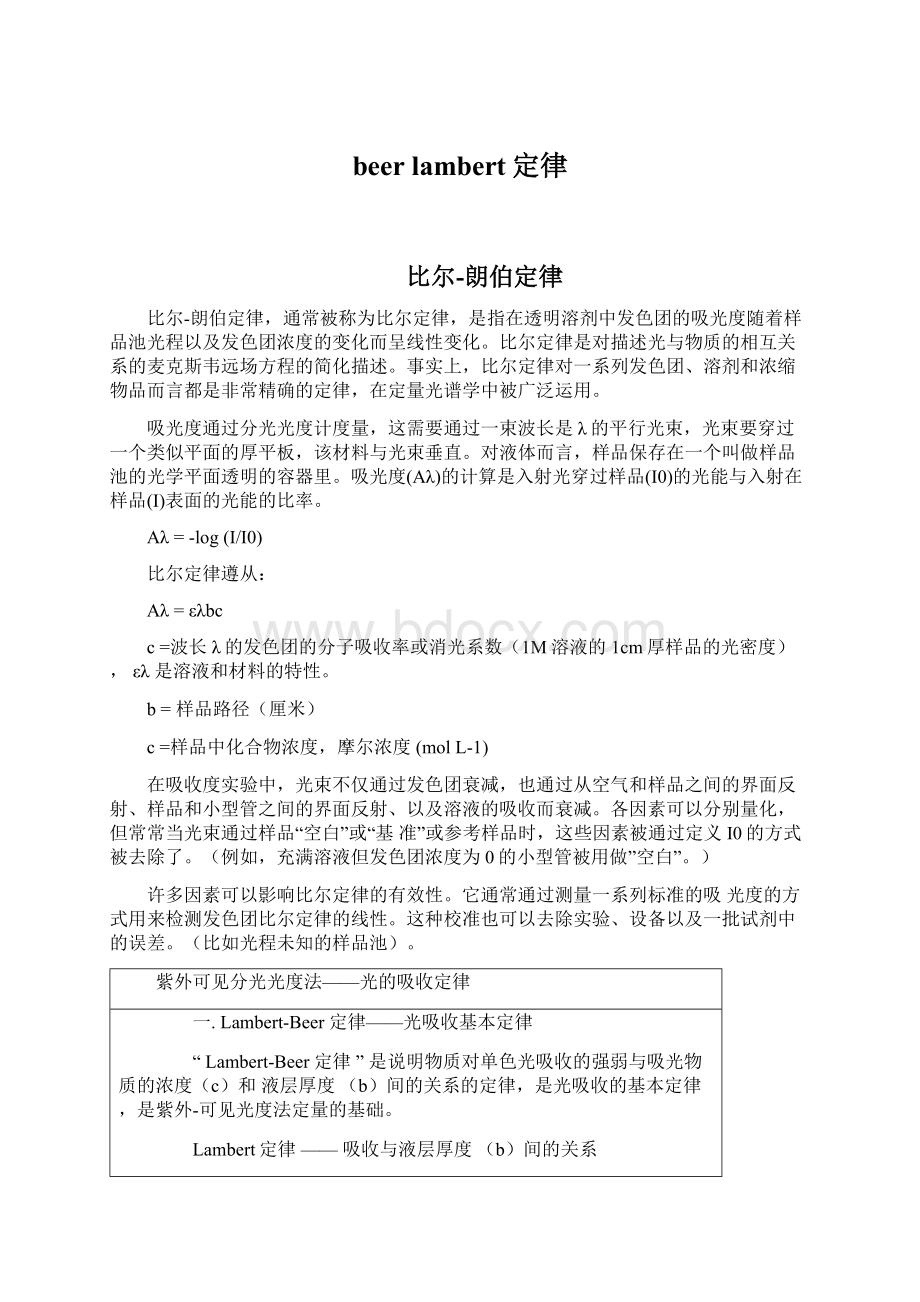 beer lambert定律.docx
beer lambert定律.docx
- 文档编号:3978083
- 上传时间:2022-11-26
- 格式:DOCX
- 页数:11
- 大小:58.36KB
beer lambert定律.docx
《beer lambert定律.docx》由会员分享,可在线阅读,更多相关《beer lambert定律.docx(11页珍藏版)》请在冰豆网上搜索。

beerlambert定律
比尔-朗伯定律
比尔-朗伯定律,通常被称为比尔定律,是指在透明溶剂中发色团的吸光度随着样品池光程以及发色团浓度的变化而呈线性变化。
比尔定律是对描述光与物质的相互关系的麦克斯韦远场方程的简化描述。
事实上,比尔定律对一系列发色团、溶剂和浓缩物品而言都是非常精确的定律,在定量光谱学中被广泛运用。
吸光度通过分光光度计度量,这需要通过一束波长是λ的平行光束,光束要穿过一个类似平面的厚平板,该材料与光束垂直。
对液体而言,样品保存在一个叫做样品池的光学平面透明的容器里。
吸光度(Aλ)的计算是入射光穿过样品(I0)的光能与入射在样品(I)表面的光能的比率。
Aλ=-log(I/I0)
比尔定律遵从:
Aλ=ελbc
c=波长λ的发色团的分子吸收率或消光系数(1M溶液的1cm厚样品的光密度),ελ是溶液和材料的特性。
b=样品路径(厘米)
c=样品中化合物浓度,摩尔浓度(molL-1)
在吸收度实验中,光束不仅通过发色团衰减,也通过从空气和样品之间的界面反射、样品和小型管之间的界面反射、以及溶液的吸收而衰减。
各因素可以分别量化,但常常当光束通过样品“空白”或“基准”或参考样品时,这些因素被通过定义I0的方式被去除了。
(例如,充满溶液但发色团浓度为0的小型管被用做”空白”。
)
许多因素可以影响比尔定律的有效性。
它通常通过测量一系列标准的吸光度的方式用来检测发色团比尔定律的线性。
这种校准也可以去除实验、设备以及一批试剂中的误差。
(比如光程未知的样品池)。
紫外可见分光光度法——光的吸收定律
一.Lambert-Beer定律——光吸收基本定律
“Lambert-Beer定律”是说明物质对单色光吸收的强弱与吸光物质的浓度(c)和液层厚度(b)间的关系的定律,是光吸收的基本定律,是紫外-可见光度法定量的基础。
Lambert定律——吸收与液层厚度(b)间的关系
Beer定律——吸收与物质的浓度(c)间的关系
“Lambert-Beer定律”可简述如下:
当一束平行的单色光通过含有均匀的吸光物质的吸收池(或气体、固体)时,光的一部分被溶液吸收,一部分透过溶液,一部分被吸收池表面反射;
设:
入射光强度为Io,吸收光强度为Ia,透过光强度为It,反射光强度为Ir,则它们之间的关系应为:
Io=Ia+It+Ir (4)
若吸收池的质量和厚度都相同,则Ir基本不变,在具体测定操作时Ir的影响可互相抵消(与吸光物质的c及b无关)
上式可简化为:
Io=Ia+It (5)
实验证明:
当一束强度为I0的单色光通过浓度为c、液层厚度为b的溶液时,一部分光被溶液中的吸光物质吸收后透过光的强度为 It,则 它们之间的关系为:
称为透光率,用T%表示。
称为吸光度,用A表示
则 A=-lgT=K·b·c (7)
此即 Lambert-Beer 定律 数学表达式。
L-B定律可表述为:
当一束平行的单色光通过溶液时,溶液的吸光度(A)与溶液的浓度(C)和厚度(b)的乘积成正比。
它是分光光度法定量分析的依据。
二.吸光度的加和性
设某一波长()的辐射通过几个相同厚度的不同溶液c1,c2......cn,其透射光强度分别为I1,I2 ......In,根据吸光度定义:
这一吸光体系的总吸光度为
而各溶液的吸光度分别为:
吸光度的和为:
即 几个(同厚度)溶液的吸光度等于各分层吸光度之和。
如果溶液中同时含有n中吸光物质,只要各组分之间无相互作用(不因共存而改变本身的吸光特性),则:
A=K1C1b1+K2C2b2+⋯⋯KnCnbn=A1+A2+⋯⋯+An (10)
应用:
①进行光度分析时,试剂或溶剂有吸收,则可由所测的总吸光度A中扣除,即以试剂或溶剂为空白的依据;
②测定多组分混合物;
③校正干扰。
三.吸光系数
Lambert-Beer 定律中的比例系数“K”的物理意义是:
吸光物质在单位浓度、单位厚度时的吸光度。
一定条件(T、及溶剂)下,K是物质的特征常数,是定性的依据。
K在标准曲线上为斜率,是定量的依据。
常有两种表示方法:
1.摩尔吸光系数():
当c用mol/L、b用cm为单位时,用摩尔吸光系数 表示,单位为L/mol·cm
A=·b·c (11)
与b及c无关。
一般不超过105数量级,通常:
>104为强吸收; <102为弱吸收;102> >104为中强吸收。
吸收系数不可能直接用1mol/L浓度的吸光物质测量,一般是由较稀溶液的吸光系数换算得到。
2.吸光系数
当c用g/L,b用cm为单位时,K用吸光系数a表示,单位为L/g·cm
A=a·b·c (12)
与a之间的关系为:
=M·a (13)
——通常多用于研究分子结构
a——多用于测定含量。
四.引起偏离Lambert-Beer 定律的因素
根据L-B 定律,A与c的关系应是一条通过原点的直线,称为“标准曲线”。
但事实上往往容易发生偏离直线的现象而引起误差,尤其是在高浓度时。
导致偏离L-B定律的因素主要有:
1.吸收定律本身的局限性
事实上,L-B 定律是一个有限的定律,只有在稀溶液中才能成立。
由于在高浓度时(通常C>0.01mol/L),吸收质点之间的平均距离缩小到一定程度,邻近质点彼此的电荷分布都会相互受到影响,此影响能改变它们对特定辐射的吸收能力,相互影响程度取决于C,因此,此现象可导致A与C线性关系发生偏差。
此外,
(n为折射率)
只有当c0.01mol/L(低浓度)时,n基本不变,才能用代替真。
2.化学因素
溶液中的溶质可因c的改变而有离解、缔合、配位以及与溶剂间的作用等原因而发生偏离L-B定律的现象。
例:
在水溶液中,Cr(Ⅵ)的两种离子存在如下平衡
Cr2O42-+H2O⇌2CrO42-+2H+
Cr2O42-、CrO42- 有不同的A值,溶液的A 值是二种离子的A之和。
但由于随着浓度的改变(稀释)或改变溶液的pH值,[Cr2O42-]/[CrO42-]会发生变化,使C总与A总的关系偏离直线。
消除方法:
控制条件。
3.仪器因素(非单色光的影响)
L-B定律的重要前提是“单色光”,即只有一种波长的光;实际上,真正的单色光却难以得到。
由于吸光物质对不同的光的吸收能力不同(不同),就导致对的偏离。
“单色光”仅是一种理想情况,即使用棱镜或光栅等所得到的“单色光”实际上是有一定波长范围的光谱带,“单色光”的纯度与狭逢宽度有关,狭缝越窄,他所包含的波长范围也越窄。
4.其它光学因素
(1)散射和反射:
浑浊溶液由于散射光和反射光而偏离L-B
(2)非平行光
Introduction
Manycompoundsabsorbultraviolet(UV)orvisible(Vis.)light.ThediagrambelowshowsabeamofmonochromaticradiationofradiantpowerP0,directedatasamplesolution.AbsorptiontakesplaceandthebeamofradiationleavingthesamplehasradiantpowerP.
Theamountofradiationabsorbedmaybemeasuredinanumberofways:
Transmittance,T=P/P0
%Transmittance,%T=100T
Absorbance,
A = log10P0/ P
A = log101 / T
A = log10100 / %T
A = 2 - log10%T
Thelastequation,A=2-log10%T,isworthrememberingbecauseitallowsyoutoeasilycalculateabsorbancefrompercentagetransmittancedata.
Therelationshipbetweenabsorbanceandtransmittanceisillustratedinthefollowingdiagram:
So,ifallthelightpassesthroughasolutionwithoutanyabsorption,thenabsorbanceiszero,andpercenttransmittanceis100%.Ifallthelightisabsorbed,thenpercenttransmittanceiszero,andabsorptionisinfinite.
TheBeer-LambertLaw
NowletuslookattheBeer-Lambertlawandexploreit'ssignificance.Thisisimportantbecausepeoplewhousethelawoftendon'tunderstandit-eventhoughtheequationrepresentingthelawissostraightforward:
A=ebc
WhereAisabsorbance(nounits,sinceA=log10P0/P)
eisthemolarabsorbtivitywithunitsofLmol-1cm-1
bisthepathlengthofthesample-thatis,thepathlengthofthecuvetteinwhichthesampleiscontained.Wewillexpressthismeasurementincentimetres.
cistheconcentrationofthecompoundinsolution,expressedinmolL-1
Thereasonwhyweprefertoexpressthelawwiththisequationisbecauseabsorbanceisdirectlyproportionaltotheotherparameters,aslongasthelawisobeyed.Wearenotgoingtodealwithdeviationsfromthelaw.
Let'shavealookatafewquestions...
Question:
WhydoweprefertoexpresstheBeer-Lambertlawusingabsorbanceasameasureoftheabsorptionratherthan%T?
Answer:
Tobegin,let'sthinkabouttheequations...
A=ebc
%T=100P/P0=e-ebc
Now,supposewehaveasolutionofcoppersulphate(whichappearsbluebecauseithasanabsorptionmaximumat600nm).Welookatthewayinwhichtheintensityofthelight(radiantpower)changesasitpassesthroughthesolutionina1cmcuvette.Wewilllookatthereductionevery0.2cmasshowninthediagrambelow.TheLawsaysthatthefractionofthelightabsorbedbyeachlayerofsolutionisthesame.Forourillustration,wewillsupposethatthisfractionis0.5foreach0.2cm"layer"andcalculatethefollowingdata:
Pathlength/cm
0
0.2
0.4
0.6
0.8
1.0
%T
100
50
25
12.5
6.25
3.125
Absorbance
0
0.3
0.6
0.9
1.2
1.5
A=ebctellsusthatabsorbancedependsonthetotalquantityoftheabsorbingcompoundinthelightpaththroughthecuvette.Ifweplotabsorbanceagainstconcentration,wegetastraightlinepassingthroughtheorigin(0,0).
NotethattheLawisnotobeyedathighconcentrations.ThisdeviationfromtheLawisnotdealtwithhere.
Thelinearrelationshipbetweenconcentrationandabsorbanceisbothsimpleandstraightforward,whichiswhyweprefertoexpresstheBeer-Lambertlawusingabsorbanceasameasureoftheabsorptionratherthan%T.
Question:
Whatisthesignificanceofthemolarabsorbtivity,e?
Answer:
TobeginwewillrearrangetheequationA=ebc:
e=A/bc
Inwords,thisrelationshipcanbestatedas"eisameasureoftheamountoflightabsorbedperunitconcentration".
Molarabsorbtivityisaconstantforaparticularsubstance,soiftheconcentrationofthesolutionishalvedsoistheabsorbance,whichisexactlywhatyouwouldexpect.
Letustakeacompoundwithaveryhighvalueofmolarabsorbtivity,say100,000Lmol-1cm-1,whichisinasolutionina1cmpathlengthcuvetteandgivesanabsorbanceof1.
e=1/1´c
Therefore,c=1/100,000=1´10-5molL-1
Nowletustakeacompoundwithaverylowvalueofe,say20Lmol-1cm-1whichisinsolutionina1cmpathlengthcuvetteandgivesanabsorbanceof1.
e=1/1´c
Therefore,c=1/20=0.05molL-1
Theanswerisnowobvious-acompoundwithahighmolarabsorbtivityisveryeffectiveatabsorbinglight(oftheappropriatewavelength),andhencelowconcentrationsofacompoundwithahighmolarabsorbtivitycanbeeasilydetected.
Question:
WhatisthemolarabsorbtivityofCu2+ionsinanaqueoussolutionofCuSO4?
Itiseither20or100,000Lmol-1cm-1
Answer:
Iamguessingthatyouthinkthehighervalueiscorrect,becausecoppersulphatesolutionsyouhaveseenareusuallyabeautifulbrightbluecolour.However,theactualmolarabsorbtivityvalueis20Lmol-1cm-1!
Thebrightbluecolourisseenbecausetheconcentrationofthesolutionisveryhigh.
b-caroteneisanorganiccompoundfoundinvegatablesandisresponsibleforthecolourofcarrots.Itisfoundatexceedinglylowconcentrations.Youmaynotbesurprisedtolearnthatthemolarabsorbtivityofb-caroteneis100,000Lmol-1cm-1!
Reviewyourlearning
YoushouldnowhaveagoodunderstandingoftheBeer-LambertLaw;thedifferentwaysinwhichwecanreportabsorption,andhowtheyrelatetoeachother.Youshouldalsounderstandtheimportanceofmolarabsorbtivity,andhowthisaffectsthelimitofdetectionofaparticularcompound.
Beer-LambertLaw
Introduction
TheBeer-Lambertlaw(orBeer'slaw)isthelinearrelationshipbetweenabsorbanceandconcentrationofanabsorbingspecies.ThegeneralBeer-Lambertlawisusuallywrittenas:
A=a(lambda)*b*c
whereAisthemeasuredabsorbance,a(lambda)isawavelength-dependentabsorptivitycoefficient,bisthepathlength,andcistheanalyteconcentration.Whenworkinginconcentrationunitsofmolarity,theBeer-Lambertlawiswrittenas:
A=epsilon*b*c
whereepsilonisthewavelength-dependentmolarabsorptivitycoefficientwithunitsofM-1cm-1.
Instrumentation
Experimentalmeasurementsareusuallymadeintermsoftransmittance(T),whichisdefinedas:
T=I/Io
whereIisthelightintensityafteritpassesthroughthesampleandIoistheinitiallightintensity.TherelationbetweenAandTis:
A=-logT=-log(I/Io).
Absorptionoflightbyasample
Modernabsorptioninstrumentscanusuallydisplaythedataaseithertransmittance,%-transmittance,orabsorbance.AnunknownconcentrationofananalytecanbedeterminedbymeasuringtheamountoflightthatasampleabsorbsandapplyingBeer'slaw.Iftheabsorptivi
- 配套讲稿:
如PPT文件的首页显示word图标,表示该PPT已包含配套word讲稿。双击word图标可打开word文档。
- 特殊限制:
部分文档作品中含有的国旗、国徽等图片,仅作为作品整体效果示例展示,禁止商用。设计者仅对作品中独创性部分享有著作权。
- 关 键 词:
- beer lambert定律 lambert 定律
 冰豆网所有资源均是用户自行上传分享,仅供网友学习交流,未经上传用户书面授权,请勿作他用。
冰豆网所有资源均是用户自行上传分享,仅供网友学习交流,未经上传用户书面授权,请勿作他用。


 如何打造酒店企业文化2刘田江doc.docx
如何打造酒店企业文化2刘田江doc.docx
